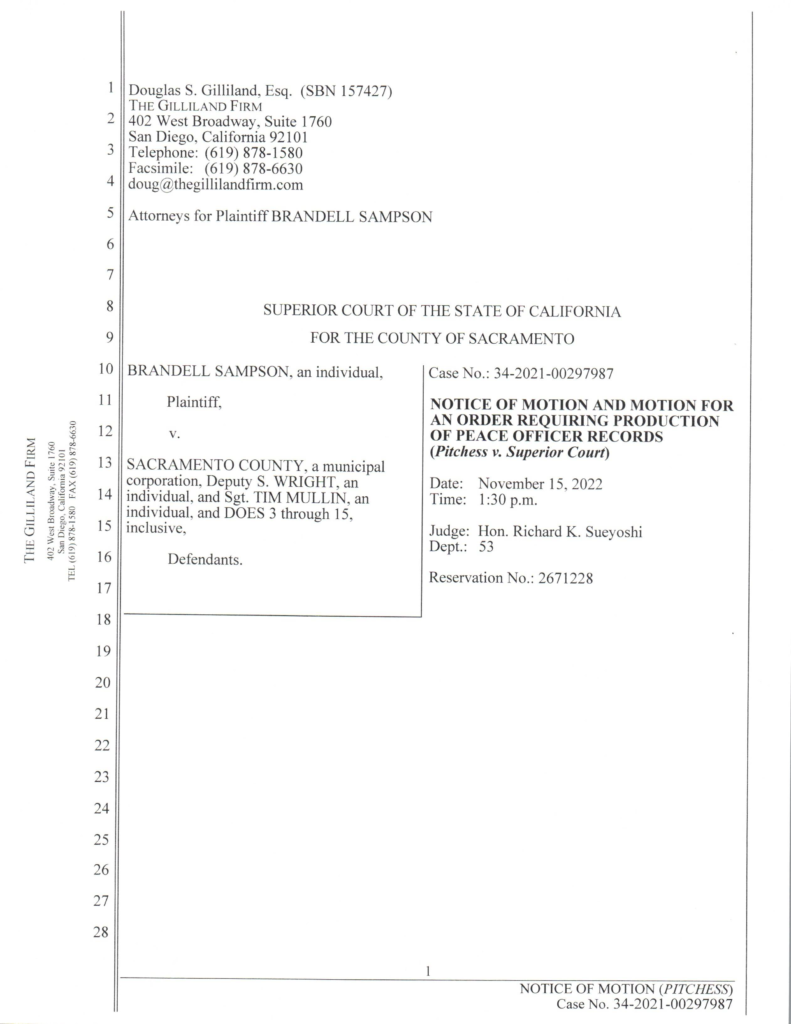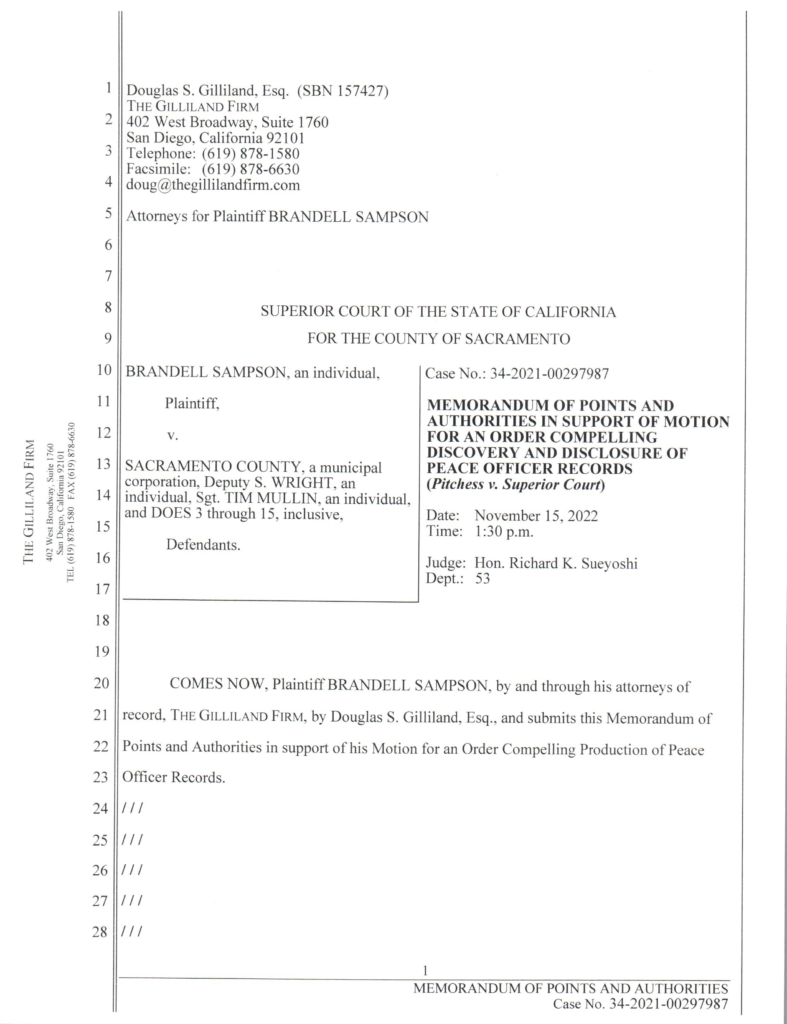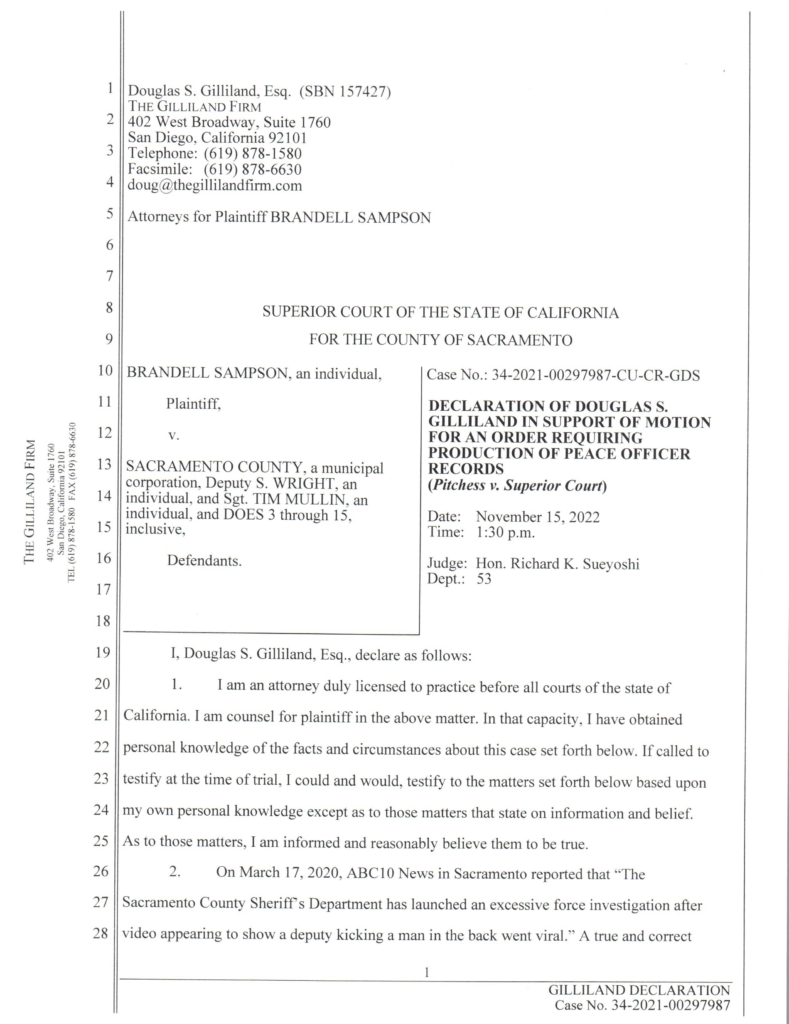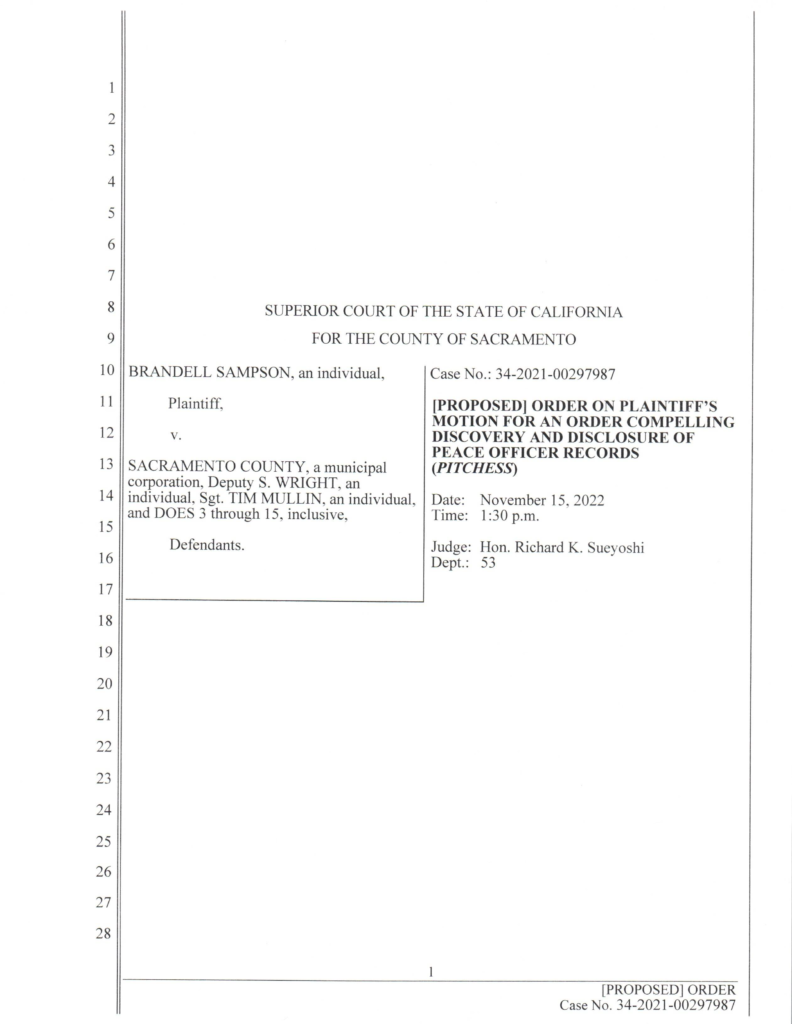How to Draft a Pitchess Motion A Very Powerful Tool
- By Douglas S. Gilliland, Esq.

How to Write a Pitchess Motions
A Very Powerful Tool
In 1974, the California Supreme Court decided the case of Pitchess v. Superior Court (1974) 11 Cal.3d 531. In so doing, it created an entirely new area of civil and criminal law and motion work called Pitchess motions. This article explains the Pitchess process and provides a sample motion to help lawyers drafting motions in their own cases.
1. Pitchess v. Superior Court
Peter Pitchess was the sheriff of Los Angeles County in 1972. That year, Caesar Echeveria was charged with battery on multiple Los Angeles County deputy sheriffs. In his criminal case, Mr. Echeveria intended to establish that he acted in self-defense. To that end, he sought to discover evidence of the officers’ propensity for violence. Specifically, he moved for production of citizen complaints against the officers alleging excessive force. The motion was granted by the trial court. However, the County refused to produce the records citing the County’s governmental interest in preserving confidentiality of its records.
The Supreme Court held that Evidence Code section 1040 provides governmental entities with a formal privilege to refuse to disclose official information. However, the privilege is conditional. The Supreme Court, quoting legislative history from section 1040, wrote, “The judge must determine in each instance the consequences to the public of disclosure and the consequences to the litigant of nondisclosure and then decide which outweighs the other.” Pitchess, supra, 11 Cal.3d at 538-539. This, in essence, is the heart of Pitchess today.
The Pitchess decision was significant because, for starters, it was a California Supreme Court decision. As Justice Robert Jackson once quipped, the Supreme Court is not final because the court is infallible, it is infallible because it is final. But just as important, it was a decision that set off alarm bells at governmental entities across the state. That is because the bottom line was the privilege for traditionally sensitive government documents, including internal affairs investigations, was no longer absolute.
2. Pitchess’s – Statutory Scheme
In reaction to the Pitchess decision, the legislature enacted several statutes which, read together, codified Pitchess and its procedures into law. Long Beach Police Officers Ass’n v. City of Long Beach (2014) 59 Cal.4th 59, 68. These “Pitchess statutes,” as the Supreme Court has called them, are set forth in Penal Code sections 832.5, 832.7, and 832.8 and Evidence Code sections 1043-1047. Although these issues are now completely statutory, motions brought pursuant to this statutory scheme are still colloquially called Pitchess motions. Highlights of the statutory scheme are as follows:
California Penal Code section 832.5 requires municipalities to establish procedures regarding complaints by the public against their peace officers. In relevant part, section 832.5 states as follows:
(a) Each department or agency in this state that employs peace officers shall establish a procedure to investigate complaints by members of the public against the personnel of these departments or agencies, and shall make a written description of the procedures available to the public.
* * *
(b) Complaints and reports or findings related to these complaints, including all
complaints and reports currently in the possession of the department or agency shall be retained for a period of no less than 5 years for records where there was not a sustained finding of misconduct and for not less than 15 years where there was a sustained finding of misconduct . . . .
(c) Complaints by members of the public that are determined by the peace or correctional officer’s employing agency to be frivolous, as defined in Section 128.5 of the Code of Civil Procedure, or unfounded or exonerated, or any portion of a complaint that is determined to be frivolous, unfounded, or exonerated, shall not be maintained in that officer’s general personal file. However, these complaints shall be retained in other, separate files that shall be deemed personnel records for the purposes of the California Public Records Act . . . . Cal. Penal Code § 832.5(a)-(c).
California Penal Code section 832.7 sets forth what records are confidential and how to obtain confidential records. Importantly, it also sets forth what records are not confidential. In relevant part, section 832.7 states as follows:
(a) Except as provided in subdivision (b), the personnel records of peace officers and custodial officers and records maintained by state or local agencies pursuant to Section 832.5, or information obtained from these records, are confidential and shall not be disclosed in any criminal or civil proceeding except by discovery pursuant to Sections 1043 and 1046 of the Evidence Code.
(b)(1) Notwithstanding subdivision (a) . . . or any other law, the following peace officer or custodial officer personnel records and records maintained by the state or local agency shall not be confidential and shall be made available for public inspection pursuant to the California Public Records Act . . . :
(A) A record relating to the report, investigation, or findings of any of the following: (i) an incident involving the discharge of a firearm at a person by a peace officer, (ii) an incident involving the use of force against a person by a peace officer or custodial officer that resulted in death or great bodily injury, (iii) a sustained finding involving a complaint that alleges unreasonable or excessive force, (iv) a sustained finding that an officer failed to intervene against another officer using force that is clearly unreasonable or excessive. . . .
(C) Any record relating to an incident in which a sustained finding was made by any law enforcement agency or oversight agency of dishonesty by a peace officer or custodial officer directly relating to the reporting, investigation, or prosecution of a crime, or directly relating to the reporting of, or investigation of misconduct by, another peace officer or custodial officer, including, but not limited to, any sustained finding of perjury, false statements, filing false reports, destruction, falsifying, or concealing of evidence.
(b)(2) Records that shall be released pursuant to this subdivision include all investigative reports; photographic, audio, and video evidence; transcripts or recordings of interviews; autopsy reports; all materials compiled and presented for review to the district attorney or to any person or body charged with determining whether to file criminal charges against an officer in connection with an incident, or whether the officer’s action was consistent with law and agency policy for purposes of discipline or administrative action, or what discipline to impose or corrective action to take; documents setting forth findings or recommended findings; and copies of disciplinary records relating to the incident, including any letters of intent to impose discipline, any documents reflecting modifications of discipline due to the Skelly or grievance process, and letters indicating final imposition of discipline or other documentation reflecting implementation of corrective action. Cal. Penal Code § 832.7(a)(b) (emphasis added).
California Evidence Code section 1043 sets forth the mandatory notice and motion requirements for a Pitchess motion and its interplay with section 832.5. In relevant part, section 1043 states,
(a) In any case in which discovery or disclosure is sought of peace or custodial officer personnel records or records maintained pursuant to Section 832.5, or information from those records, the party seeking the discovery or disclosure shall file a written motion with the appropriate court . . . upon written notice to the governmental agency which has custody and control of the records. The
written notice shall be given at the times prescribed by subdivision (b) of Section 1005 of the Code of Civil Procedure. Upon receipt of the notice the government agency served shall immediately notify the individual whose records are sought.
(b) The motion shall include all of the following:
(1) Identification of the proceeding in which discovery or disclosure is sought, the party seeking discovery or disclosure, the peace or custodial officer whose records are sought, the governmental agency which has custody and control of the records, and the time and place at which the motion for discovery or disclosure shall be heard.
(2) A description of the type of records or information sought.
(3) Affidavits showing good cause for the discovery or disclosure sought, setting forth [1] the materiality thereof to the subject matter involved in the pending litigation and [2] stating upon reasonable belief that the governmental agency identified has the records or information from the records.
(c) No hearing upon a motion for discovery or disclosure shall be held without full compliance with the notice provisions of this section . . . . Cal. Evid. Code § 1043(a)-(c).
California Evidence Code section 1045 sets forth the type of records that the Pitchess statutes do not protect, i.e., they are discoverable without the need for a Pitchess motion. In relevant part, section 1045 states:
(a) Nothing in this article shall be construed to affect the right of access to records of complaints, or investigations of complaints, or discipline imposed as a result of those investigations, concerning an event or transaction in which the
peace officer or custodial officer participated, or which he or she perceived, and pertaining to the manner in which he or she performed his or her duties, provided that information is relevant to the subject matter involved in the pending litigation. Cal. Evid. Code § 1045(a).
3. The Showing Required to Trigger an In Camera Review
A peace officer has a strong privacy interest in his or her personnel records. Haggerty v. Superior Court (2004) 117 Cal.App.4th 1079, 1085. But the Pitchess statutes recognize that evidence contained in a peace officer’s personnel records may also be relevant in a lawsuit. To balance these competing interests, the Legislature requires “a neutral trial judge” to examine these records in camera, and order production of those records that satisfy the required statutory showing. Id. at 1085, 1087 (citing City of San Jose v. Superior Court (1993) 5 Cal.4th 47, 53).
The Pitchess statutes require a party seeking Pitchess information, to identify the records with “some specificity.” Warrick v. Superior Court (2005) 35 Cal.4th 1011, 1021. And the request must be supported by a declaration showing “good cause.” Evid. Code § 1043(b)(3). Good cause requires the declarant to show two things: (1) that the information sought is “material” to the case, and (2) a “reasonable belief” that the governmental entity has the information. City of Santa Cruz v. Municipal Court (1989) 49 Cal.3d 79, 90. However, personal knowledge of the declarant is not required. The legislature “expressly considered and rejected a requirement of personal knowledge” for section 1043(b)(3) declarations. [1] Id. at 88-89 (emphasis original). As stated by the California supreme court, the declaration can be based on “information and belief.” City of Santa Cruz v. Municipal Court (1989) 49 Cal.3d 74, 80.
The California Supreme Court has held that the trial court is not tasked with evaluating the moving party’s theories, weighing or assessing the allegations; a party must simply present a plausible factual foundation for the discovery, a scenario that could or might have occurred. Warrick, supra, 35 Cal.4th at 1025-1026. Therefore, good cause is a “relatively low threshold for discovery.” Id. at 1019. Importantly, the Pitchess statutes have been defined as “expansive.” Haggerty, supra, 117 Cal.App.4th at 1087. In other words, “[r]elevant information under section 1045 is “not limited to facts that may be admissible at trial, but may include facts that could lead to the discovery of admissible evidence.” Id. (emphasis added). The “relatively relaxed standards” serve to ensure that “all potentially relevant documents” are produced for the trial court’s in camera review. [2] Warrick, supra, 35 Cal.4th at 1016.
4. The In Camera Review
If the trial court concludes the moving party has fulfilled the statutory prerequisites and made a showing of good cause, the custodian of the records will bring to the court all documents “potentially relevant” to the motion. People v. Mooc (2001) 26 Cal.4th 1216, 1226. The trial court examines the information in chambers of the presence and hearing of all persons except the person authorized to possess the records and such other persons the custodian of records is willing to have present. Id. The trial court will then disclose to the moving party such information that is relevant to the subject matter of the litigation.
5. Practice Tips
Start the process early. Unlike civil discovery which must be answered in 30 days, a Pitchess motion often takes months. Much of that time is simply waiting for the next available hearing date. A Pitchess motion should be part of your initial written discovery plan.
When writing your motion, focus first on non-confidential information under Penal Code section 832.7. This is the low-hanging fruit. For example, one category of non-confidential information under the statute is information regarding “a sustained finding involving a complaint that alleges unreasonable or excessive force.” Penal Code § 832.7(b)(1)(A)(iii). If the trial judge identifies documents that are not confidential, there is no weighing necessary; you are entitled to the documents. Another category of non-confidential information is a sustained finding of dishonesty. Penal Code § 823.7(b)(1)(C). Again, always request this information and use the statutory language when describing non-confidential information.
When addressing your requests that seek confidential information, the affidavit or declaration is critical. That is because, you do not get any documents unless you establish good cause in your declaration. As you can imagine, these motions get very complex. The easiest thing for a judge to rule on is confidential records not supported by good cause in an affidavit or declaration. You can have every reason in the world to justify production of certain records, but if good cause is not set forth in an affidavit or declaration, your request will be denied.
Finally, make it easy on the trial court. Make it clear to the court what statutory section and/or case law supports production of each stated category. And cite to the paragraphs in your declaration that show good cause for production. There is no better way to do this than a proposed order. Write a proposed order that sets forth clearly the documents sought, whether or not they seek statutorily confidential or non-confidential information, and cite to your affidavit or declaration showing good cause for the production.
Below are some links to a Pitchess motion in PDF format. I have also included a version in Word format which will make writing your motion much easier.
[1] Because the requesting party often does not know what documents exist, a general description of categories of documents will suffice. City of Santa Cruz, supra, 49 Cal.3d at 90-91 (a request seeking “other complaints of excessive force” sufficiently describes the type of documents sought and meets the standard for good cause) (emphasis added).
[2] In 2004, California voters passed an initiative which amended the California constitution. It requires trial courts to “narrowly construe” statutes that limit public access to government information (arguably the Pitchess statutes). Long Beach Police Officers Association, supra, 59 Cal.4th at 68 (citing Cal. Const., art. I, § 3, subd. (b)(2)). However, this constitutional amendment, by its own terms, does not affect any statute regulating disclosure of information concerning “official performance or professional qualifications of a peace officer.” Id. Therefore, the oft cited rule of narrow construction is not applicable to the Pitchess statutes nor this court’s Pitchess analysis.




